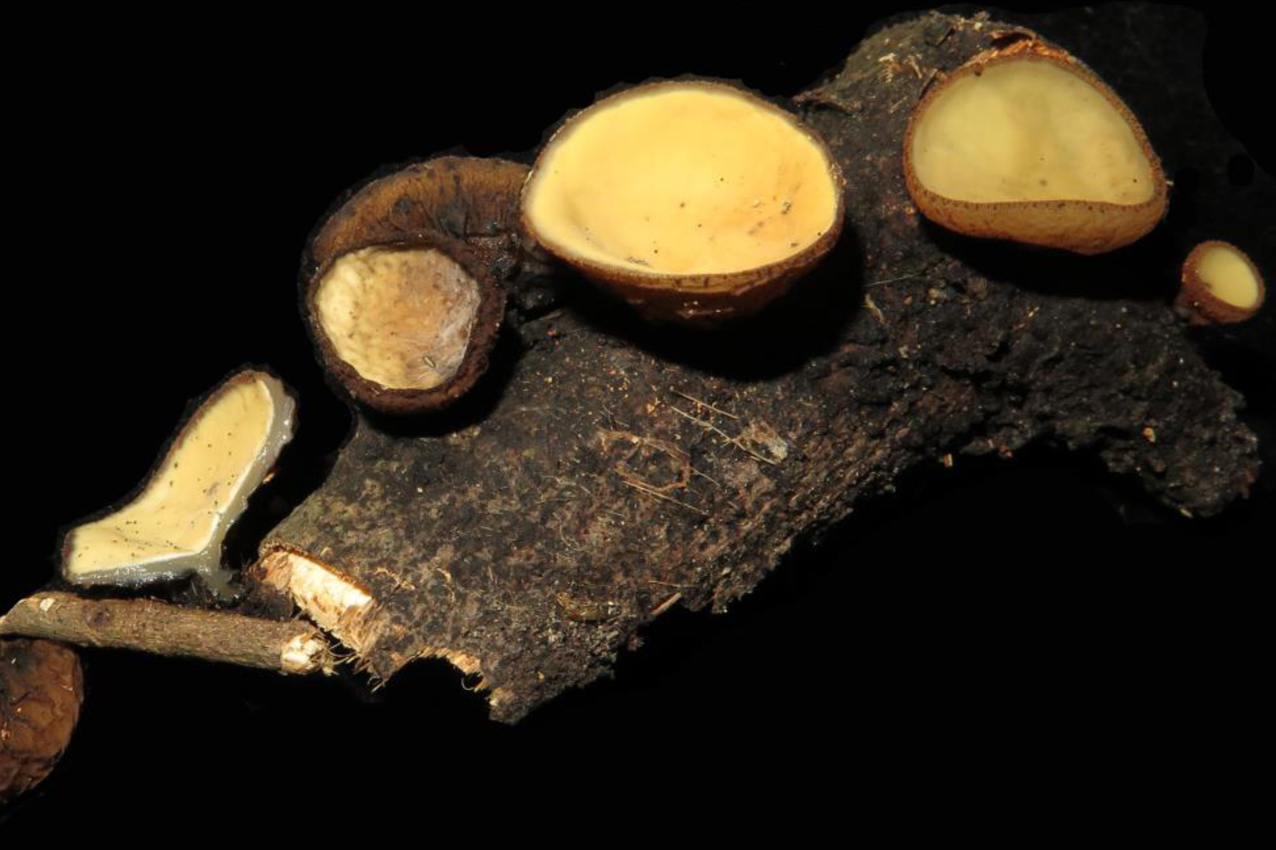Abstract
Plectania lutea, is described as a new species from subtropical karst areas of China. The main distinguishing characteristics of P. lutea are the yellow hymenium, the external surface with ridges, the gelatinous but not semifluid medullary excipulum, and the large finely warted ascospores. The phylogenetic analyses based on internal transcribed spacer (ITS) and the large subunit (LSU) regions of rDNA sequences using Bayesian (BA) and Maximum Likelihood (ML) methods showed that the new taxon can be distinguished from phenotypically similar and phylogenetically related species.
References
<p>Carbone, M., Agnello, C. & Alvarado, P. (2013) Phylogenetic studies in the family Sarcosomataceae (Ascomycota, Pezizales). <em>Ascomycete.org</em> 5 (1): 1–12.</p>
<p>Carbone, M., Agnello, C. & Bomanz, B. (2015a) Studies in <em>Galiella</em> (Ascomycota, Pezizales) I. Notes on <em>Galiella rufa</em>. <em>Ascomycete.org</em> 7 (2): 55–60.</p>
<p>Carbone, M., Loizides, M. & Alvarado, P. (2015b) Preliminary phylogenetic and morphological studies in the <em>Plectania melastoma</em> lineage (Ascomycota, Pezizales). <em>Ascomycete.org</em> 7 (1): 23–29.</p>
<p>Fuckel, K.W.G.L. (1870) Symbolae mycologicae. Beiträge zur Kenntniss der Rheinischen Pilze. <em>Jahrbücher des Nassauischen Vereins für Naturkunde</em> 23–24: 1–459. https://doi.org/10.5962/bhl.title.47117</p>
<p>Kirk, P.M., Cannon, P.F., Minter, D.W. & Stalpers, J.A. (2008) Dictionary of the fungi 10th ed. Wallingford: CABI International, 544 pp.</p>
<p>Korf, R.P. (1957) Two Bulgarioid Genera: <em>Galiella</em> and <em>Plectania</em>. <em>Mycologia</em> 49 (1): 107–111. https://doi.org/10.1080/00275514.1957.12024617</p>
<p>Kornerup, A. & Wanscher, J.H. (1978) <em>Methuen handbook of colour.</em> Eyre Methuen, London, 252 pp.</p>
<p>Nylander, J. (2004) MrModeltest 2.3. Computer program and documentation distributed by the author. Evolutionary Biology Centre, Uppsala University, Uppsala.</p>
<p>Rambaut, A. (2012) <em>FigTree</em> v1. 4. Molecular evolution, phylogenetics and epidemiology. Edinburgh, UK: University of Edinburgh, Institute of Evolutionary Biology.</p>
<p>Ronquist, F. & Huelsenbeck, J.P. (2003) MrBayes 3: bayesian phylogenetic inference under mixed models. <em>Bioinformatics</em> 19: 1572–1574. https://doi.org/10.1093/bioinformatics/btg180</p>
<p>Stamatakis, A., Ludwig, T. & Meier, H. (2005) RAxML-III: a fast program for maximum likelihood-based inference of large phylogenetic trees. <em>Bioinformatics</em> 21: 456–463. https://doi.org/10.1093/bioinformatics/bti191</p>
<p>White, T.J., Bruns, T., Lee, S. & Taylor, J. (1990) Amplification and direct sequencing of fungal ribosomal RNA genes for phylogenetics.<em> In: </em>Innis, M.A., Gelfand, D.H., Sninsky, J.J. & White, T.J. (Eds.) <em>PCR Protocols: A Guide to Methods and Applications.</em> Academic Press, New York, pp. 315–322. https://doi.org/10.1016/B978-0-12-372180-8.50042-1</p>
<p>Xu, A.S. (2000) Notes on <em>Plectania</em> in XiZang. <em>Mycosystema</em> 19 (2): 2000–2004.</p>
<p>Zhuang, W.Y. & Wang, Z. (1998) Sarcosomataceous discomycetes in China. <em>Mycotaxon</em> 67: 355–364.</p>
<p>Zhuang, W.Y. (2004) <em>Flora Fungorum Sinicorum</em> (Vol. 21): Hyaloscyphaceae Sarcoscyphaceae et Sarcosomataceae. Science press, Beijing, 192 pp.</p>
<p>Carbone, M., Agnello, C. & Bomanz, B. (2015a) Studies in <em>Galiella</em> (Ascomycota, Pezizales) I. Notes on <em>Galiella rufa</em>. <em>Ascomycete.org</em> 7 (2): 55–60.</p>
<p>Carbone, M., Loizides, M. & Alvarado, P. (2015b) Preliminary phylogenetic and morphological studies in the <em>Plectania melastoma</em> lineage (Ascomycota, Pezizales). <em>Ascomycete.org</em> 7 (1): 23–29.</p>
<p>Fuckel, K.W.G.L. (1870) Symbolae mycologicae. Beiträge zur Kenntniss der Rheinischen Pilze. <em>Jahrbücher des Nassauischen Vereins für Naturkunde</em> 23–24: 1–459. https://doi.org/10.5962/bhl.title.47117</p>
<p>Kirk, P.M., Cannon, P.F., Minter, D.W. & Stalpers, J.A. (2008) Dictionary of the fungi 10th ed. Wallingford: CABI International, 544 pp.</p>
<p>Korf, R.P. (1957) Two Bulgarioid Genera: <em>Galiella</em> and <em>Plectania</em>. <em>Mycologia</em> 49 (1): 107–111. https://doi.org/10.1080/00275514.1957.12024617</p>
<p>Kornerup, A. & Wanscher, J.H. (1978) <em>Methuen handbook of colour.</em> Eyre Methuen, London, 252 pp.</p>
<p>Nylander, J. (2004) MrModeltest 2.3. Computer program and documentation distributed by the author. Evolutionary Biology Centre, Uppsala University, Uppsala.</p>
<p>Rambaut, A. (2012) <em>FigTree</em> v1. 4. Molecular evolution, phylogenetics and epidemiology. Edinburgh, UK: University of Edinburgh, Institute of Evolutionary Biology.</p>
<p>Ronquist, F. & Huelsenbeck, J.P. (2003) MrBayes 3: bayesian phylogenetic inference under mixed models. <em>Bioinformatics</em> 19: 1572–1574. https://doi.org/10.1093/bioinformatics/btg180</p>
<p>Stamatakis, A., Ludwig, T. & Meier, H. (2005) RAxML-III: a fast program for maximum likelihood-based inference of large phylogenetic trees. <em>Bioinformatics</em> 21: 456–463. https://doi.org/10.1093/bioinformatics/bti191</p>
<p>White, T.J., Bruns, T., Lee, S. & Taylor, J. (1990) Amplification and direct sequencing of fungal ribosomal RNA genes for phylogenetics.<em> In: </em>Innis, M.A., Gelfand, D.H., Sninsky, J.J. & White, T.J. (Eds.) <em>PCR Protocols: A Guide to Methods and Applications.</em> Academic Press, New York, pp. 315–322. https://doi.org/10.1016/B978-0-12-372180-8.50042-1</p>
<p>Xu, A.S. (2000) Notes on <em>Plectania</em> in XiZang. <em>Mycosystema</em> 19 (2): 2000–2004.</p>
<p>Zhuang, W.Y. & Wang, Z. (1998) Sarcosomataceous discomycetes in China. <em>Mycotaxon</em> 67: 355–364.</p>
<p>Zhuang, W.Y. (2004) <em>Flora Fungorum Sinicorum</em> (Vol. 21): Hyaloscyphaceae Sarcoscyphaceae et Sarcosomataceae. Science press, Beijing, 192 pp.</p>


